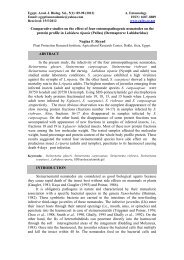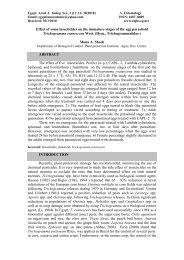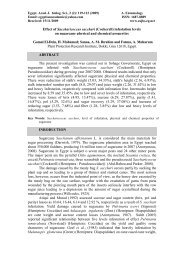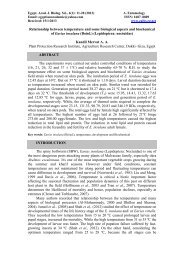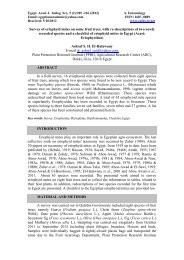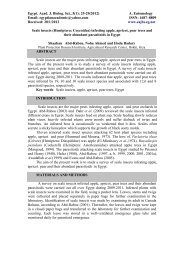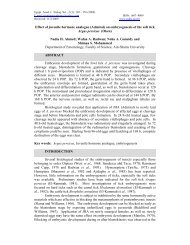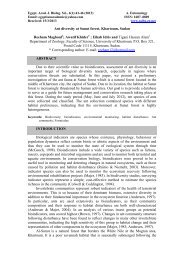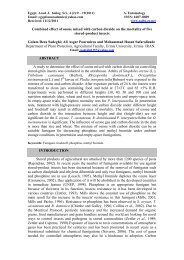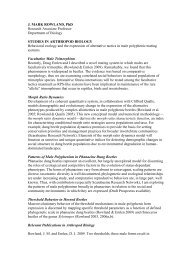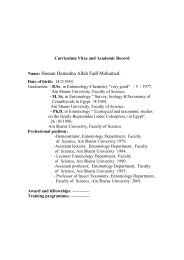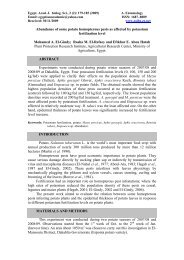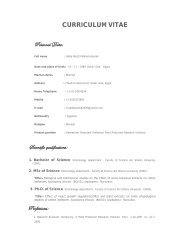Heat Requirements for the Development of the Black cutworm ...
Heat Requirements for the Development of the Black cutworm ...
Heat Requirements for the Development of the Black cutworm ...
You also want an ePaper? Increase the reach of your titles
YUMPU automatically turns print PDFs into web optimized ePapers that Google loves.
Egypt. Acad. J. biolog. Sci., 2 (1): 117- 124 (2009)<br />
E. mail. egyptianacademic@yahoo.com ISSN: 1687 – 8809<br />
Received: 10/1/2009 www.eajbs.eg.net<br />
<strong>Heat</strong> <strong>Requirements</strong> <strong>for</strong> <strong>the</strong> <strong>Development</strong> <strong>of</strong> <strong>the</strong> <strong>Black</strong> <strong>cutworm</strong>, Agrotis ipsilon<br />
(Hüfnagel) (Noctuidae: Lepidoptera)<br />
Hassan F. Dahi; Walaa G. Ibrahem and Mohsen M. Ali<br />
Plant Protection Research Institute, Agricult. Research Center, Dokki, Giza, Egypt.<br />
ABSTRACT<br />
The present investigation aimed to study <strong>the</strong> effect <strong>of</strong> three constant<br />
temperatures (20, 25, and 30°C) on <strong>the</strong> development <strong>of</strong> <strong>the</strong> black <strong>cutworm</strong>, Agrotis<br />
ipsilon (Hüfnagel). The incubation period, larval duration, pupal duration, preoviposition<br />
period and duration <strong>of</strong> generation were estimated. The time required <strong>for</strong><br />
development was decreased as <strong>the</strong> temperature increased from 20 to30 °C. The<br />
lower threshold temperatures (t0) was 11.49°C <strong>for</strong> eggs, 10.63 °C <strong>for</strong> larvae, 9.83<br />
°C <strong>for</strong> pupae, 11.06 °C <strong>for</strong> pre-oviposition period and 10.53 °C <strong>for</strong> generation. The<br />
average <strong>the</strong>rmal requirements needed <strong>for</strong> completing <strong>the</strong> development were 51.3,<br />
303.5, 183.5, 38.1 and 575.3 degree-days <strong>for</strong> eggs, larvae, pupae, pre-oviposition<br />
period and generation, respectively.<br />
Key words: Agrotis ipsilon – <strong>Heat</strong> <strong>Requirements</strong> – Degree Days - Lower threshold<br />
(t0) - Prediction.<br />
INTRODUCTION<br />
The <strong>Black</strong> <strong>cutworm</strong>, A. ipsilon, is one <strong>of</strong> <strong>the</strong> most important and abundant<br />
species <strong>of</strong> noctuidae in Egypt. It has become widely spread in recent years and its<br />
various ravages against field crops have been steadily increasing. It causes<br />
considerable damage to many <strong>of</strong> <strong>the</strong> more important field crops and vegetables.<br />
The influence <strong>of</strong> temperature in determining <strong>the</strong> development <strong>of</strong> insect<br />
populations is well established (Davidson, 1944 and Ives, 1973); since <strong>the</strong><br />
temperature is considered an important environmental factor that affects <strong>the</strong> rate <strong>of</strong><br />
development <strong>of</strong> insects. There is a lower threshold temperature <strong>for</strong> each insect. No<br />
development occurs when temperature is below that level. Insects also have an<br />
optimum temperature range in which <strong>the</strong>y will develop rapidly. Then, <strong>the</strong>re is<br />
maximum temperature (termed upper cut<strong>of</strong>f) above which development stops.<br />
These values can be used in predicting insect activity and appearance <strong>of</strong> symptoms<br />
during <strong>the</strong> growing season (Wagner et al., 1984).<br />
The present work was pointed mainly on <strong>the</strong> follow aspects:<br />
(1) Relationship between temperature and rate <strong>of</strong> development, which gives a<br />
quantitive expression <strong>for</strong> this relationship by using <strong>the</strong>rmal accumulation.<br />
(2) Studying certain biological aspects <strong>of</strong> A. ipsilon as a prior to limit its required<br />
heat units to be used through <strong>for</strong>ecasting system <strong>for</strong> establishment IPM program <strong>for</strong><br />
its control.<br />
(3) The <strong>the</strong>rmal units required to complete <strong>the</strong> development <strong>of</strong> different stages to<br />
complete one generation, as well as helping in <strong>the</strong> design <strong>of</strong> development indexes,<br />
used <strong>for</strong> determining <strong>the</strong> times required <strong>for</strong> <strong>the</strong>se stages under fluctuating<br />
temperatures in <strong>the</strong> field. This such points were previously studied by Pedigo,<br />
1991; Younis, 1992; Dahi, 1997; Hashem et al., 1997; Dahi, 2003 ; Dahi, 2005 ;<br />
Ismail et al., 2005 and Dahi and Abdel-khalek 2006.
118<br />
Hassan F. Dahi et al.<br />
MATERIALS AND METHODS<br />
A good number <strong>of</strong> A. ipsilon, larvae were collected from wild host plants at<br />
Dakahlya Governorate. The larvae were reared on caster oil leaves under laboratory<br />
condition (27 ± 1 °C) <strong>for</strong> at least four generations be<strong>for</strong>e experimentation.<br />
Each <strong>of</strong> A. ipsilon stages was kept under three constant temperatures (20, 25<br />
and 30°C ± 1°C) to determine its rate <strong>of</strong> development. Eggs were transferred to<br />
glass vials (2.0 X 7.5 cm); four replicates <strong>of</strong> 25 eggs each were used <strong>for</strong> each <strong>of</strong> <strong>the</strong><br />
temperature to be tested.<br />
Observations were made daily to record <strong>the</strong> time <strong>of</strong> hatchability. The<br />
incubation period and <strong>the</strong> embryo developmental rates were estimated. Newly<br />
hatched larvae were confined in a separate glass tube (7.5 X 2.5 cm) with adequate<br />
castor oil leaves (Ricinus commnuis) <strong>for</strong> feeding. Sawdust was placed at <strong>the</strong> bottom<br />
<strong>of</strong> <strong>the</strong> tubes and <strong>the</strong> top was covered with muslin cloth, secured with rubber band<br />
and maintained in <strong>the</strong> incubators running at 20, 25 and 30 °C. The pupae were kept<br />
in similar tubes, and under <strong>the</strong> same conditions, till moth emergence. After being<br />
sexed, <strong>the</strong> newly emerged moths at each temperature were isolated in pairs, each in<br />
a separate The pairs <strong>of</strong> newly emerged <strong>of</strong> moths were confined in glass oviposition<br />
cages, which consisted <strong>of</strong> a conventional mating glass bells (16 cm. high and 8 cm.<br />
diam.)opened at each end. Each cage had suspended piece <strong>of</strong> cotton wool<br />
previously soaked in 10 % sugar solution. This solution was renewed after 48 hours<br />
<strong>for</strong> moths feeding. The cages were provided with strips <strong>of</strong> muslin, suspended on its<br />
wide end as a suitable site <strong>for</strong> oviposition.<br />
Daily observations <strong>for</strong> each treatment were made to record <strong>the</strong> different<br />
durations <strong>of</strong> <strong>the</strong> embryo, larvae, pupae, pre-oviposition period as well as generation<br />
<strong>of</strong> A. ipsilon under experiment conditions.<br />
The rates <strong>of</strong> development <strong>for</strong> A. ipsilon stages (incubation period, larval<br />
duration, pupal duration, pre-oviposition period and generation) were determined<br />
by <strong>the</strong> simple <strong>for</strong>mula (1/t x 100) <strong>for</strong> three constant temperatures.<br />
Data obtained in <strong>the</strong> present work were subjected to statistical analysis by<br />
regression. The <strong>the</strong>oretical development thresholds were determined according to<br />
<strong>the</strong> following:<br />
Y = a + bx<br />
t0 = -a / b & K = 1 / b<br />
Where: (a): Constant term; (b): Regression coefficient; (r): Correlation coefficient;<br />
(t0): lower threshold <strong>of</strong> development and (K): <strong>the</strong>rmal units (degree-days).<br />
On <strong>the</strong> o<strong>the</strong>r hand, <strong>the</strong>rmal units required <strong>for</strong> completion <strong>of</strong> development<br />
<strong>of</strong> each stage were determined according to <strong>the</strong> equation <strong>of</strong> <strong>the</strong>rmal summation<br />
(Blunk, 1923):<br />
K = y (T - t0)<br />
Where y = developmental duration <strong>of</strong> a given stage; T= temperature in degree<br />
centigrade; t0 = lower threshold <strong>of</strong> development and K = <strong>the</strong>rmal units (degree -<br />
days).<br />
RESULTS AND DISCUSSION<br />
Egg stag:<br />
Data in Table (1) show <strong>the</strong> relationship between A .ipsilon incubation<br />
period and constant temperatures <strong>of</strong> 20, 25 and 30C. This relationship indicated<br />
that <strong>the</strong> required time <strong>for</strong> completion <strong>of</strong> egg development decreased as <strong>the</strong>
<strong>Heat</strong> <strong>Requirements</strong> <strong>for</strong> <strong>the</strong> <strong>Development</strong> <strong>of</strong> <strong>the</strong> <strong>Black</strong> <strong>cutworm</strong>, Agrotis ipsilon 119<br />
temperature increased. The means <strong>of</strong> incubation periods were 6.18, 3.67 and 2.81<br />
days at 20, 25 and 302C, respectively. Statistically, <strong>the</strong>re are obvious significant<br />
differences in A. ipsilon incubation period at all <strong>the</strong> tested constant temperatures.<br />
Table (1): <strong>Development</strong> <strong>of</strong> A. ipsilon eggs under different constant temperatures and its <strong>the</strong>rmal requirements.<br />
Temp.<br />
( °C)<br />
Incubation<br />
period<br />
(days ± S.E) Expect<br />
duration (days)<br />
Rate <strong>of</strong><br />
development<br />
%<br />
Expect rate <strong>of</strong><br />
development<br />
%<br />
20 6.18 ± 0.04 a 6.02 16.18 16.61<br />
to<br />
(˚C)<br />
Degree days<br />
(dd΄s)<br />
25 3.67 ± 0.18 b 3.79 27.24 26.37 11.49 49.6<br />
30 2.81 ± 0.02 c 2.77 35.71 36.14 51.8<br />
Average 51.3<br />
L.S.D 0.16<br />
The threshold <strong>of</strong> egg development was calculated and illustrated in Fig. (1);<br />
it was found to be 11.49C. The average <strong>of</strong> <strong>the</strong>rmal units in degree – days required<br />
<strong>for</strong> <strong>the</strong> completion <strong>of</strong> development <strong>of</strong> this stage was 51.3 dd's. The three observed<br />
values <strong>of</strong> eggs rate <strong>of</strong> development at <strong>the</strong> constant temperature range (20 - 30C)<br />
gave a remarkable good fit to <strong>the</strong> calculated temperature – velocity line having <strong>the</strong><br />
<strong>for</strong>mula Y = 1.95 x - 22.4 (Fig. 1).<br />
R a t e o f d e v(1/t e l ox1 p0 ) m0 e n t<br />
4 0<br />
3 5<br />
3 0<br />
2 5<br />
2 0<br />
1 5<br />
1 0<br />
5<br />
0<br />
r = 0 . 9 9 K = 5 1 . 3<br />
y = 1 . 9 x5 - 2 2 . 4<br />
0 5 1 0 1 5 2 0 2 5 3 0<br />
T e m p e r a t u r e ( ° C)<br />
F i g . ( 1 ) : T h e r e g r e s s i o n l i n e o f t h e r e l a t i o n b e t w e e n t h e<br />
r a t e o f d e v e l o p m e n t o f A . i p s i l o n e g g s a n d d i f f e r e n t<br />
Fig. (1): The regression line <strong>of</strong> <strong>the</strong> relation c o nbetween s t a n t t e m<strong>the</strong> p e rate r a t u r<strong>of</strong> e s development .<br />
<strong>of</strong> A. ipsilon eggs and<br />
different constant temperatures.<br />
Larval stage:<br />
Table (2) indicated that <strong>the</strong> average larval duration varied from 33.06 days<br />
at 20C to 15.81 days at 30C. The analysis <strong>of</strong> variance showed significant<br />
differences (P < 0.01) between <strong>the</strong> means <strong>of</strong> larval duration at all tested<br />
temperatures. The lower threshold <strong>of</strong> development (t 0) <strong>for</strong> <strong>the</strong> larval stage was<br />
10.63C as indicated in Fig. (2).<br />
The same Table showed that <strong>the</strong> average <strong>the</strong>rmal units required <strong>for</strong> larval<br />
developmental till pupation was 303.5 dd's as determined by <strong>the</strong> <strong>the</strong>rmal<br />
summation equation.<br />
52.6
120<br />
Hassan F. Dahi et al.<br />
The three observed values <strong>for</strong> larval rate <strong>of</strong> development at rang <strong>of</strong><br />
temperature from 20 to 30C, gave also a remarkable good fit to <strong>the</strong> calculated<br />
temperature – velocity line having <strong>the</strong> <strong>for</strong>mula Y =0.33 x -3.51 (Fig.2).<br />
Table (2): <strong>Development</strong> <strong>of</strong> A. ipsilon larvae under different constant temperatures and its <strong>the</strong>rmal requirements.<br />
Temp.<br />
( °C)<br />
Larvae duration<br />
(days ± S.E)<br />
Expected<br />
duration<br />
(days)<br />
Rate <strong>of</strong><br />
development %<br />
Expect rate<br />
<strong>of</strong><br />
development<br />
%<br />
20 33.06 ± 0.32 a 32.36 3.02 3.09<br />
to<br />
(˚C)<br />
Degree<br />
days<br />
(dd΄s)<br />
309.8<br />
25 20.49 ± 0.33 b 21.14 4.88 4.73 10.63 294.4<br />
30 15.81 ± 0.12 c 15.65 6.32 6.39 306.2<br />
Average 303.5<br />
L.S.D 0.43<br />
Fig. (2): The regression line <strong>of</strong> <strong>the</strong> relation between <strong>the</strong> rate <strong>of</strong> development <strong>of</strong> A. ipsilon larvae and<br />
different constant temperatures.<br />
Pupal stage<br />
Concerning <strong>the</strong> effects <strong>of</strong> <strong>the</strong> three tested constant temperatures on <strong>the</strong><br />
pupal duration <strong>of</strong> A. ipsilon (Table 3) it is noticed generally that <strong>the</strong> pupal period<br />
decreased as temperature increased from 20 to 30C. The average durations were<br />
18.15, 12.00 and 9.12days at 20, 25 and 30 C, respectively. Statistical analysis<br />
referred to significant differences (P < 0.01) between <strong>the</strong> pupal duration and <strong>the</strong><br />
tested constant temperatures.<br />
Table (3): <strong>Development</strong> <strong>of</strong> A. ipsilon pupae under different exposure <strong>of</strong> constant temperatures and its relation<br />
with <strong>the</strong>rmal requirements.<br />
Temp.<br />
( °C)<br />
R a t e o f d e v e(1/t l o px1m 0 ) e0n t<br />
Pupal duration<br />
(days ± S.E)<br />
Expect duration<br />
(days)<br />
Rate <strong>of</strong><br />
developme<br />
nt<br />
Expect rate <strong>of</strong><br />
<strong>Development</strong> %<br />
20 18.15 ± 0.15 a 18.05 5.51 5.54<br />
to<br />
(˚C)<br />
Degree Days<br />
(DD΄s)<br />
184.6<br />
25 12.00 ± 0.06 b 12.1 8.33 8.26 9.83 182.0<br />
30 9.12 ± 0.09 c 9.09 10.96 10.99 184.0<br />
Average 183.5<br />
L.S.D 0.42<br />
8<br />
7<br />
6<br />
5<br />
4<br />
3<br />
2<br />
1<br />
0<br />
r = 0 . 9 9 K = 3 0 3 . 5<br />
y = 0 . 3 3x<br />
-3 . 5 1<br />
0 5 1 0 1 5 2 0 2 5 3 0 3 5<br />
T e m p e r a t u r e ( ° C)<br />
F i g . ( 2 ) : T h e r e g r e s s i o n l i n e o f t h e r e l a t i o n b e t w e e n t h e<br />
r a t e o f d e v e l o p m e n t o f A . i p s i l o n l a r v a e a n d d i f f e r e n t<br />
c o n s t a n t t e m p e r a t u r e s .
<strong>Heat</strong> <strong>Requirements</strong> <strong>for</strong> <strong>the</strong> <strong>Development</strong> <strong>of</strong> <strong>the</strong> <strong>Black</strong> <strong>cutworm</strong>, Agrotis ipsilon 121<br />
The developmental zero <strong>for</strong> this stage was 9.83C as illustrated graphically<br />
by extrapolation in Fig. (3).The average <strong>of</strong> <strong>the</strong>rmal heat units <strong>for</strong> A. ipsilon pupae<br />
was 183.5dd’s as estimated by <strong>the</strong> <strong>the</strong>rmal summation equation.<br />
The three observed values <strong>for</strong> <strong>the</strong> pupal rate <strong>of</strong> development at <strong>the</strong><br />
temperature range from 20 to 30C gave a remarkable good fit to <strong>the</strong> calculated<br />
temperature – velocity line having <strong>the</strong> <strong>for</strong>mula Y = 0.545 x - 5.35 (Fig. 3).<br />
R a t e o f d e v e l(1/t o p x1 m 0e ) 0n<br />
t<br />
1 4<br />
1 2<br />
1 0<br />
8<br />
6<br />
4<br />
2<br />
0<br />
r = 0 . 9 9 K = 1 8 3 . 5<br />
y = 0 . 5 4 x5 - 5 .3 5<br />
0 5 1 0 1 5 2 0 2 5 3 0 3 5<br />
T e m p e r a t u r e ( ° C)<br />
F i g . ( 3 ) : T h e r e g r e s s i o n l i n e o f t h e r e l a t i o n b e t w e e n t h e<br />
r a t e o f d e v e l o p m e n t o f A . i p s i l o n p u p a e a n d d i f f e r e n t<br />
c o n s t a n t t e m p e r a t u r e s .<br />
Fig. (3): The regression line <strong>of</strong> <strong>the</strong> relation between <strong>the</strong> rate <strong>of</strong> development <strong>of</strong> A. ipsilon pupae and<br />
different constant temperatures.<br />
Adult stage<br />
1-Pre-Oviposition period<br />
Data in Table (4) show that <strong>the</strong> mean period required <strong>for</strong> maturation <strong>of</strong> <strong>the</strong><br />
ovaries and starting to egg laying, decreased as <strong>the</strong> temperature increased (from 4.2<br />
days at 20C to 2.00 days at 30 C). The analysis <strong>of</strong> variance showed significant<br />
differences (P < 0.01) between <strong>the</strong> means <strong>of</strong> <strong>the</strong> pre-oviposition period at all <strong>the</strong><br />
tested constant temperatures.<br />
Table (4): Duration <strong>of</strong> A. ipsilon pre-Oviposition period under different constant temperatures and its <strong>the</strong>rmal<br />
requirements.<br />
Temp.<br />
(°C)<br />
Pre-Oviposition<br />
Period<br />
(days ± S.E)<br />
Expect<br />
duration<br />
Rate <strong>of</strong><br />
increase<br />
%<br />
Expect rate<br />
<strong>of</strong> increase %<br />
to<br />
(˚C)<br />
Degree<br />
Days<br />
(DD΄s)<br />
20 4.2 ± 0.17 a 4.27 23.81 23.41<br />
37.5<br />
25 2.8 ± 0.33 b 2.73 35.71 36.5 11.06 39.0<br />
30 2.00 ± 0.11 c 2.01 50.00 49.6 37.9<br />
Average 38.1<br />
L.S.D 0.37<br />
The lower threshold <strong>of</strong> development was 11.06C. The average <strong>of</strong> total<br />
<strong>the</strong>rmal units was 38.1dd’s as calculated by <strong>the</strong>rmal summation equation.
122<br />
Hassan F. Dahi et al.<br />
The three observed values <strong>for</strong> pre-oviposition rate <strong>of</strong> increase at rang <strong>of</strong><br />
temperature from 20 to 30C, gave also a remarkable good fit to <strong>the</strong> calculated<br />
temperature – velocity line having <strong>the</strong> <strong>for</strong>mula Y = 2.619 x - 28.96 (Fig.4).<br />
Fig. ( 4): The regression line <strong>of</strong> a<strong>the</strong> n d drelation i ffe r e n t c obetween n s t a n t t e m<strong>the</strong> p e rrate a t u r e<strong>of</strong> s . development <strong>of</strong> A. ipsilon<br />
pre-oviposition period and different constant temperatures.<br />
The generation<br />
The mean duration <strong>of</strong> generation at different constant temperature regimes<br />
could be calculated using <strong>the</strong> total <strong>of</strong> mean duration <strong>of</strong> different developmental<br />
stages (i.e. incubation period, larval stage, pupal stage and pre-oviposition period).<br />
Theoretically, <strong>the</strong> results obtained from are method showed an approximate value<br />
<strong>for</strong> mean duration <strong>of</strong> generation at different constant temperature regimes.<br />
In <strong>the</strong> present study, <strong>the</strong> data in Table (5) indicate that <strong>the</strong> mean duration <strong>of</strong><br />
generation <strong>for</strong> A. ipsilon was 61.59, 38.96 and 29.73days at 20, 25 and 30 C,<br />
respectively. Data revealed that <strong>the</strong> increasing <strong>of</strong> temperature accelerated <strong>the</strong><br />
developmental rate <strong>of</strong> A. ipsilon where it reached a maximum velocity at 30 C.<br />
Table (5): Duration <strong>of</strong> A. ipsilon generation under different constant temperatures and its <strong>the</strong>rmal<br />
requirements.<br />
Temp.<br />
(°C)<br />
R a te o f d e v e lo p(1/t m ex1 n t0<br />
0)<br />
Duration <strong>of</strong><br />
generation<br />
(days ± S.E)<br />
Expected<br />
duration (days)<br />
Rate <strong>of</strong><br />
increase<br />
%<br />
Expected<br />
rate <strong>of</strong><br />
increase %<br />
t o<br />
(˚C)<br />
Degree<br />
Days<br />
(DD΄s)<br />
20 61.59 ± 1.37 a 60.97 1.62 1.64<br />
583.3<br />
25 38.96 ± 0.94 b 39.84 2.57 2.51 10.53 563.8<br />
30 29.73 ± 0.66 c 29.58 3.36 3.38 578.8<br />
Average 575.3<br />
L.S.D 1.23<br />
5 0<br />
4 0<br />
3 0<br />
2 0<br />
1 0<br />
0<br />
r = 0 . 9 9 K = 3 8 . 1<br />
y = 2 .6 1 9 x - 2 8 .9 6<br />
0 5 1 0 1 5 2 0 2 5 3 0 3 5<br />
T e m p e ra t u re ( ° C)<br />
F i g . ( 4 ) : T h e r e g r e s s i o n l i n e o f t h e r e l a t i o n b e t w e e n t h e<br />
r a t e o f d e v e l o p m e n t o f A . i p s i l o n p r e - o v i p o s i t i o n p e r i o d<br />
The lower threshold <strong>of</strong> development (t 0) could be estimated graphically<br />
by extrapolation from Fig. (5), it was 10.53C and <strong>the</strong> average <strong>the</strong>rmal summation<br />
was 575.3 dd's.<br />
These results agreed with <strong>the</strong> findings obtained by Kajanshikov (1946)<br />
who found that <strong>the</strong> linear relationship between temperature and rate <strong>of</strong> development
<strong>Heat</strong> <strong>Requirements</strong> <strong>for</strong> <strong>the</strong> <strong>Development</strong> <strong>of</strong> <strong>the</strong> <strong>Black</strong> <strong>cutworm</strong>, Agrotis ipsilon 123<br />
can be expressed by <strong>the</strong> <strong>for</strong>mula K = y (T– t0). George and phillip (1983) found that<br />
<strong>the</strong> developmental rates increased with increasing <strong>of</strong> temperature.<br />
R a t e o f d e v e l o(1/t p mx1 e0n 0) t<br />
Fig. (5): The regression line r a t e <strong>of</strong> o f d<strong>the</strong> e v erelation l o p m e n t between o f A . i p s i<strong>the</strong> l o n rate g e n e<strong>of</strong> r adevelopment t i o n a n d d i f f e <strong>of</strong> r e nA. t ipsilon generation<br />
c o n s t a n t t e m p e r a t u r e s .<br />
and different constant temperatures.<br />
The results in <strong>the</strong> present study are in agreement with Gergis et al.,<br />
(1990); Abdel-Hafez; Gergis et al., 1994, Dahi, 1997, Dahi 2005 and Dahi 2006..<br />
REFERENCES<br />
4<br />
3 . 5<br />
3<br />
2 . 5<br />
2<br />
1 . 5<br />
1<br />
0 . 5<br />
0<br />
r = 0 . 9 9 K = 5 7 5 . 3<br />
y = 0 . 1 7 4x<br />
- 1 . 8 3<br />
0 5 1 0 1 5 2 0 2 5 3 0 3 5<br />
T e m p e r a t u r e ( ° C)<br />
F i g . ( 5 ) : T h e r e g r e s s i o n l i n e o f t h e r e l a t i o n b e t w e e n t h e<br />
Abdel-Hafez, A.; S. H. Taher; G. M. Moawad and KH. GH. El-Malki (1993). The<br />
combined effect <strong>of</strong> high temperature and exposure period regimes on some<br />
biological aspects <strong>of</strong> pink bollworm Pectinophora gossypiella<br />
(Saund.).Egypt. J. Appl. Sci., 8 (7): 485-493.<br />
Blunk, M. (1923). Die Entwicklung Von Dytiscus marginalis L.Vom. Ei bis Zur<br />
Imago, 2 Teil. Die Metamorphase Zracht-Wiss. Sool, 121-171.<br />
Dahi, H. F. ( 1997). New approach <strong>for</strong> management <strong>the</strong> population <strong>of</strong> cotton<br />
leafworm Spodoptera littoralis (Boisd.) and pink bollworm Pectinophora<br />
gossypiella (Saund.) in Egypt. M. Sc. Thesis, Fac. Agric., Cairo University,<br />
149 pp.<br />
Dahi, H. F. (2003). Predicting <strong>the</strong> annual generations <strong>of</strong> <strong>the</strong> spiny bollworm Earias<br />
insulana (Boisd.) (Lepidoptera: Ar chtidae). Ph. D. Thesis, Fac. Agric.,<br />
Cairo Univ., 182 pp.<br />
Dahi, H. F. (2005). Egyptian cotton leafworm Spodoptera littoralis development on<br />
artificial diet in relation to heat unit requirements. Egypt. J. Agric. Res., 83<br />
(1):199-209.<br />
Dahi, H. F. and S. M. Abdel-khalek (2006). Threshold Temperature and Thermal<br />
requirements <strong>of</strong> <strong>the</strong> Lesser Cotton Leafworm Spodoptera exigua Hb. Bull.<br />
Ent. Soc. Egypt, 83: 271-281.<br />
Davidson, J. (1944). On <strong>the</strong> relation between temperature and rate <strong>of</strong> development<br />
<strong>of</strong> insects at constant temperatures. J. Anim. Ecol., 13: 26-38.<br />
George, C. R. and S. L. Phillip (1983). <strong>Development</strong>al rates <strong>of</strong> codling moth<br />
(Lepidoptera:Olethreutidae) reared on apple at four constant temperatures.<br />
Environ. Entomol., 12 (3) : 831-834.
124<br />
Hassan F. Dahi et al.<br />
Gergis, M. F.; M. A. Soliman; E. A. M<strong>of</strong>tah and A. A. Abdel-Naby (1990).<br />
Temperature-<strong>Development</strong> relationship <strong>of</strong> spiny bollworm Earias insulana<br />
(Boisd.).Assiut J. Agric. Sci., 21 (3): 129-139.<br />
Hashem, M. Y.; I. I. Ismail; S. A. Emara and H. F. Dahi (1997). Seasonal<br />
fluctuations <strong>of</strong> <strong>the</strong> pink bollworm, Pectinophora gossypiella (Saund.) and<br />
prediction <strong>of</strong> generations in relation to heat units accumulation. Bull.<br />
Entomol. Soc. Egypt, 75: 140-151.<br />
Ismail, I.I.; M.Y. Hashem;S. A .Emara and H. F. Dahi (2005). <strong>Heat</strong> requirements<br />
<strong>for</strong> spiny bollworm Earias insulana (Boisduval) (Lepidoptera: Arctiidae).<br />
Bull. Ent. Soc. Egypt, 82:255-265.<br />
Ives, W. G. H. ( 1973). <strong>Heat</strong> units and outbreaks <strong>of</strong> Malacosoma disstria.Can.<br />
Entomol. 105: 529-543.<br />
Kajanshikov, N.B. ( 1946). Kbonpocy oxnbhehhom tempnueckom ontnmyme 8olabnlbhoctn<br />
npuoueccob pazbntna hacekomblx bothowehnn<br />
tempnuecknx bilnahnn-300-Lx4 Prl. 25(C): 27-35.<br />
Pedigo, L. P. ( 1991). Entomology and pest management text bood., Macmillan<br />
Publishing Company, New Your, pp.197-198.<br />
Wagner, T. L.; H. I. Wu; P. J. H. Sharpe; R. M. Schoolfield and R. N. Coulson<br />
(1984).Modeling insect development rates:A literature review and<br />
application <strong>of</strong> a biophysical model. Ann Entomol. Soc. Amer., 77:208-<br />
225.<br />
Younis, A. M. ( 1992). Some biological aspects <strong>of</strong> cotton leafworm, Spodoptera<br />
littoralis (Boisd.) under different temperature regimes. Bull. Entomol.,<br />
Soc., Egypt, Vol. 70: 171-184.<br />
ﻲﻠﻋ<br />
( م ° 30،<br />
25 ، 20 )<br />
ARABIC SUMMARY<br />
ءادﻮﺴﻟا ﺔﺿرﺎﻘﻟا ةدوﺪﻟا<br />
ﻮﻤﻨﻟ ﺔﻣزﻼﻟا<br />
ﻲﻠﻋ ﺪﻤﺤﻣ ﻦﺴﺤﻣ -<br />
ﻻو – ﻲﺣﺎﺿ جﺮﻓ ﻦﺴﺣ<br />
. – ﻲﻗﺪﻟا – <br />
<br />
<br />
،<br />
. ﺔﻔﻠﺘﺨﻤﻟ ا راﻮﻃﻼﻟ<br />
ﺮﻔﺻ وا يدﺎﺼﺘﻗﻻا ﻮﻤﻨﻟا ﺔﺒﺘﻋ ) ﻮﻤﻨﻠﻟ جﺮﺤﻟا ﺪﺤﻟا ﻎﻠﺑ<br />
. <br />
ﻗﺎﻣ ةﺮﺘﻓ ،ءارﺬﻌﻟا<br />
م°<br />
11.06 ن ءارﺬﻌﻟ ا رﻮﻄﻟ م ° 9.83 ، ° 1063<br />
م°<br />
11.49 ( <br />
. (<br />
) ﻞﻣﺎ ﻜﻟ ا<br />
° 10.53 ﺾ<br />
، 38.1 ن 183.5 ، 303.5 ، 51.3<br />
ﺪﺤﺗ<br />
575.3<br />
.<br />
ﻲﻟاﻮﺘﻟا ﻲﻠﻋ



